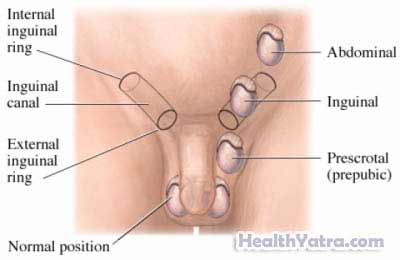সংজ্ঞা
Testicular cancer is a disease in which cancer cells grow in one or both testicles. The testicles are a pair of male sex glands that make and store sperm. The testicles also make male hormones. They are located under the penis in a sac-like pouch called the scrotum.
There are three main types of testicular cancer:
- Seminomas
- Nonseminomas (yolk sac, embryonal cell carcinoma, teratomas, and choriocarcinoma)
- Stromal cell tumors
Treatment will vary depending on the cell প্রকার
Cancer occurs when cells in the body (in this case testicular cells) divide without control or order. Normally, cells divide in a regulated manner. If cells keep dividing uncontrollably when new cells are not needed, a mass of tissue forms, called a growth or tumor. The term cancer refers to malignant tumors, which can invade nearby tissues and spread to other parts of the body. A benign tumor does not invade or spread.
কারণসমূহ
The causes of testicular cancer are unknown. However, research shows that certain risk factors are associated with the disease.
ঝুঁকির কারণ
These factors increase your chance of developing testicular cancer. Tell your doctor if you have any of these risk factors:
- Personal or family history of testicular cancer
- জাতি: সাদা
- Age: 25-35
- Abnormal testicular development, such as that seen in Klinefelter syndrome
- Undescended testicle that did not move down into the scrotum before birth

লক্ষণ
If you have any of these symptoms do not assume it is due to testicular cancer. These উপসর্গ সৃষ্টি হতে পারে অন্যান্য শর্ত দ্বারা। আপনার যদি এইগুলির মধ্যে কোনটি থাকে তবে আপনার ডাক্তারকে বলুন:
- A painless lump or swelling in either testicle
- Enlargement or swelling of a testicle or change in the way it feels
- Feeling of heaviness in the scrotum
- A dull ache in the lower abdomen or groin
- Fluid in the scrotum that appears suddenly
- Pain or discomfort in a testicle or in the scrotum
- Lower back pain (in later stages of the cancer)
- Enlarged breasts
রোগ নির্ণয়
ডাক্তার আপনার উপসর্গ এবং চিকিৎসা ইতিহাস সম্পর্কে জিজ্ঞাসা করবেন এবং একটি শারীরিক পরীক্ষা করবেন। পরীক্ষা অন্তর্ভুক্ত হতে পারে:
- রক্ত পরীক্ষা
- Ultrasound—a test that uses sound waves to find or examine tumors
- Excisional biopsy—removal of testicles to test for cancer cells
Once testicular cancer is found, tests may be done to find out if the cancer has spread and, if so, to what extent. These imaging tests of the body may include:
- গণনা করা টমোগ্রাফি (সিটি স্ক্যান
- Positron emission tomography (PET)
- চৌম্বকীয় অনুরণন ইমেজিং (MRI)
চিকিৎসা
সার্জারি
Surgery requires removing the cancerous testicle. This is done through an incision in the groin. The surgeon may also remove nearby lymph nodes to check for metastasis.
বিকিরণ থেরাপির
Radiation therapy is the use of radiation to kill cancer cells and shrink tumors. Radiation therapy for testicular cancer comes from a machine outside the body that directs radiation at the abdomen.
কেমোথেরাপি
Chemotherapy is the use of drugs to kill cancer cells. Chemotherapy may be given in many forms including: pill, injection, and via a catheter. The drugs enter the bloodstream and travel through the body killing mostly cancer cells, but also some healthy cells.
প্রতিরোধ
If you were born with undescended testicles, having surgery to correct this condition may reduce your risk of getting testicular cancer.
The United States Preventive Services Task Force (USPSTF) does not recommend regular screening by a doctor or self-screening in men who do not have any symptoms. However, the American Cancer Society recommends that your doctor at your routine cancer-related check-ups should do a testicular exam. No studies have been done that look at the benefit or harm of screening for testicular cancer. Discuss screening with your doctor, especially if you are at high risk for testicular cancer.
Keep in mind that if you notice any symptoms of testicular cancer, such as a lump or swelling in the testicles, it is important that you see your doctor for an evaluation.
